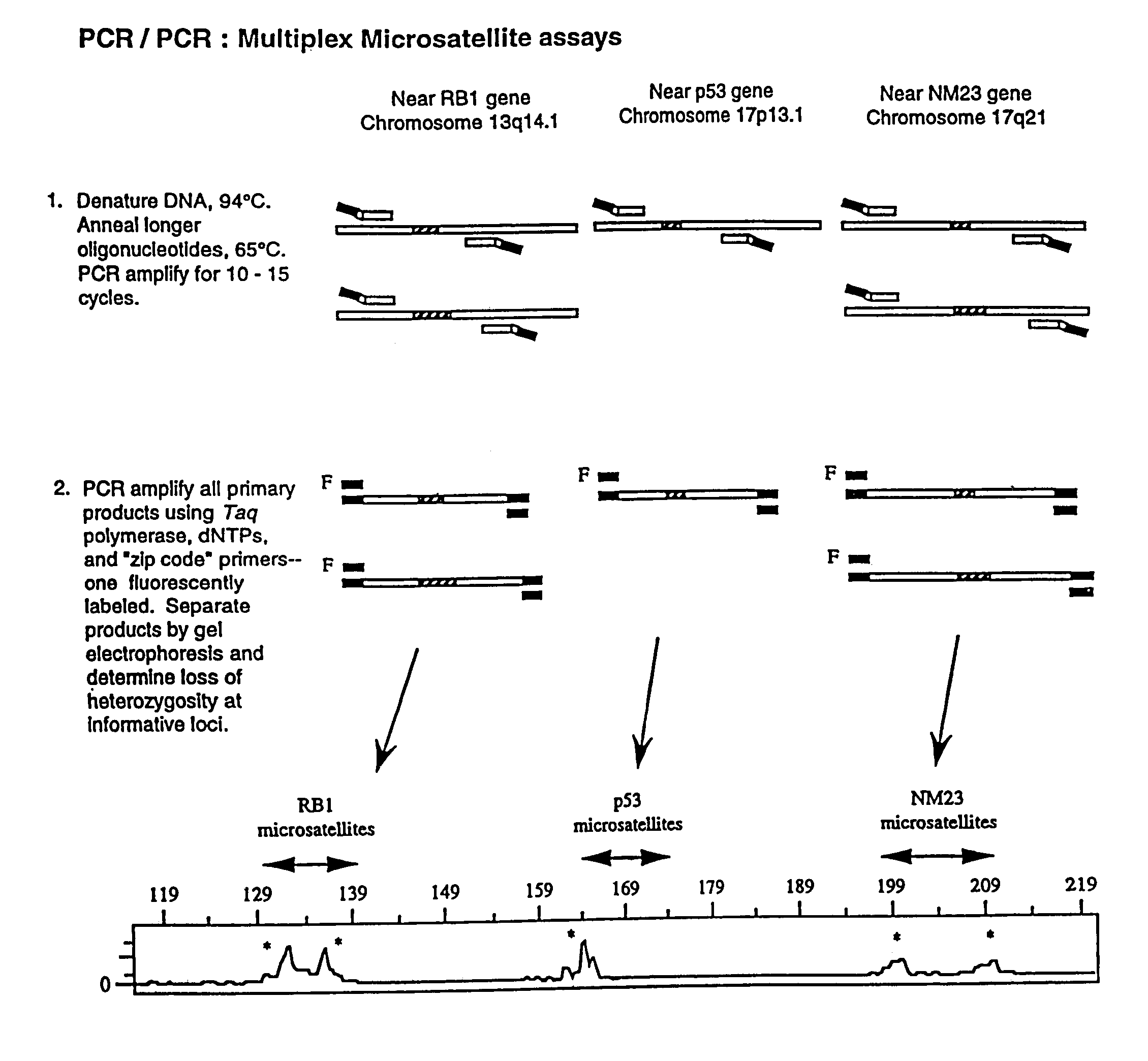Detection of nucleic acid sequence differences using coupled ligase detection and polymerase chain reactions
a technology polymerase chain reaction, which is applied in the field of nucleic acid sequence differences detection, can solve the problems of mismatches that interfere with the formation of such a polymerase chain reaction product, and achieve the effect of less primers and maximum production of primary extension products
- Summary
- Abstract
- Description
- Claims
- Application Information
AI Technical Summary
Benefits of technology
Problems solved by technology
Method used
Image
Examples
example 1
Genomic DNA Preparation
[0174]Genomic DNA was prepared from the blood of two normal human volunteers, one male and one female, according to standard techniques. Briefly, approximately 12 ml of blood was obtained in EDTA-containing blood collection tubes. Red blood cells were lysed by mixing the blood samples with 4 volumes of lysis buffer (10 mM Tris pH 8.0, 10 mM EDTA). After 10 min on ice with occasional agitation, the suspensions were centrifuged and the supernatants were decanted. The white blood cell pellets were resuspended in 20 ml of lysis buffer, and the above process was repeated. Each cell pellet was then suspended in 15 ml of digestion buffer (50 mM Tris pH 8.0, 5 mM EDTA, 100 mM NaCl, 1% SDS) and 3 mg (0.2 mg / ml) of proteinase K was added. The cells were digested at 37° C. for 5 hours. The digests were extracted twice with equal volumes of phenol, then once with equal volumes of a 1:1 phenol:chloroform mixture and finally once with equal volumes of chloroform, each time ...
example 2
Oligonucleotide Preparation for LDR Probes and PCR Primers
[0177]All oligonucleotides were synthesized on a 394A DNA Synthesizer (Applied Biosystems Division of Perkin-Elmer Corp., Foster City, Calif.). Oligonucleotides labeled with 6-FAM were synthesized using the manufacturer's suggested modifications to the synthesis cycle (Applied Biosystems Inc., 1994) and were subsequently deprotected at 55° C. for 4 hr. LDR oligonucleotides were purified by ethanol precipitation after overnight deprotection at 55° C. The primer-specific portions of the oligonucleotides used for PCR amplification were purified by polyacrylamide gel electrophoresis on 10% acrylamide / 7M urea gels. Oligonucleotides were visualized after electrophoresis by UV shadowing against a lightening screen and excised from the gel (Applied Biosystems Inc., 1992). They were then eluted overnight at 64° C. in TNE (i.e. Tris-sodium EDTA) buffer (100 mM Tris / HCl pH 8.0 containing 500 mM NaCl and 5 mM EDTA) and recovered from the...
example 3
Buffers and Reagents
A. LDR Buffers / Reagents—the following LDR buffers and reagents were selected:
[0188]10×ST ligase buffer (0.2 M Tris pH 8.5, 0.1 M MgCl2) [This was also tested with Tris at pH 7.6.][0189]10×TT ligase buffer (0.2 M Tris pH 7.6, 0.5 M KCl, 0.1 M MgCl2, 5 mM EDTA)[0190]NAD (10 mM)[0191]DTT (200 mM)[0192]LDR primer solution containing one tenth concentration of each of the LDR primer mixtures (50 fm of each LDR primer per μl)[0193]Tth DNA Ligase (625 U / μl)
PCR Buffers / Reagents—the following PCR buffers and reagents were selected:[0194]10× Stoffel buffer (0.1 M KCl, 0.1M Tris-HCl pH 8.3 Perkin Elmer)[0195]dNTP solution (100 mM total, 25 mM of each dNTP Perkin Elmer), diluted 5 fold in dHOH to a final concentration of 5 mM of each dNTP[0196]ZipALg1F (10 pm / μl)[0197]ZipBLg2R (10 pm / μl)
PUM
| Property | Measurement | Unit |
|---|---|---|
| temperature | aaaaa | aaaaa |
| temperature | aaaaa | aaaaa |
| volume | aaaaa | aaaaa |
Abstract
Description
Claims
Application Information
 Login to View More
Login to View More - R&D
- Intellectual Property
- Life Sciences
- Materials
- Tech Scout
- Unparalleled Data Quality
- Higher Quality Content
- 60% Fewer Hallucinations
Browse by: Latest US Patents, China's latest patents, Technical Efficacy Thesaurus, Application Domain, Technology Topic, Popular Technical Reports.
© 2025 PatSnap. All rights reserved.Legal|Privacy policy|Modern Slavery Act Transparency Statement|Sitemap|About US| Contact US: help@patsnap.com



